In a year of upheaval, our Anselmian educators have had to dig deep, pivot quickly, and sacrifice much-becoming better teachers along the way.
Last August, St. Benedict’s Preparatory School departed from a 150-year tradition. The all-boys Catholic Benedictine school in Newark, N.J., created a separate girls’ division. The headmaster and board made a decision they had begun considering before the pandemic. Then, they figured out how to make it happen—in short order.
“Schools are about taking care of people,” says Ivan Lamourt, Psy.D. ’86, senior associate headmaster and counselor at St. Benedict’s Preparatory School and a Saint Anselm College trustee. “Catholic schools have been closing left and right in New Jersey. When the all-girls Benedictine high school closed [due to financial difficulties], those students needed an option. Juniors wanted to finish their education at a school infused with the Benedictine charism. That charism includes a strong sense of community, stability, and hospitality.”
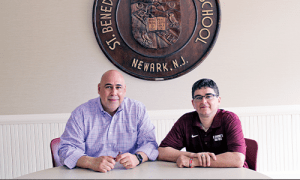
It was a big change. But change—and doing what needs to be done—is what the last 18 months have been all about for Anselmians in the field of education. They became experts at “the Corona pivot,” altering schedules and lesson plans at the drop of a hat. They taught in person, partly in person, and remotely. They counseled children who were fearful of getting sick and children who lost family members to the Coronavirus. They learned new technologies, delivered school supplies to students in high-crime neighborhoods, and found 3D paper models of birds so biology students could complete dissections at home.
In emphasizing Benedictine values, Lamourt expresses what many Anselmians drew on as they taught children during the pandemic. Until recently, one thing teachers all had in common was that they saw their pupils every day. Suddenly, there was a chasm between teacher and student that could not be crossed except via the often-shaky bridge of the internet.
“It was a tremendous blow. Teachers have felt that in our hearts,” Lamourt says. St. Benedict’s, like most schools, went remote when the pandemic hit. “After 9/11, we were able to be together the next day and begin to process it. We didn’t have that opportunity when this happened. We had that loss coupled with a tremendous amount of fear—especially working in a disenfranchised community where we have issues of racial inequality and a digital divide.”
As a counselor, Lamourt says that not seeing the students was especially hard, and the school brought students back to the building as soon as it could. “I know when you’re in front of me if your face doesn’t look right. 2D fools you. It’s easier to hide what you’re feeling on camera. We thrive on connection. We work hard on community because we see that it really works. How to stick together is taught at Saint Anselm.”
His thoughts are echoed by Anselmian educators in preschools, inner city public schools, private day schools, and residential facilities. Across the board, these teachers say they missed their students and mourned the loss of in-person learning. The hours were long and stress levels often high. Some educators, including Lamourt, contracted Covid-19. But there have been positives too. They discovered the incredible resilience of children and became better problem solvers. They came up with innovations they never would have imagined. Across the board, they say they learned new ways of teaching and believe new technologies will benefit the world of education long after the pandemic is over.
Making the Best of a Bad Situation
Zachary Camenker ’16 comes from a family of teachers: His mother teaches preschool and his grandfather taught high school. As eventful as their careers were, it’s a safe bet they never had a year like Camenker’s. His fifth year of teaching coincided with a historic global pandemic.
“In this profession, you’re taught that you’ll need to adjust, and you do. But we’ve had to adjust constantly,” says the seventh-grade language arts teacher at Ross A. Lurgio Middle School. The Bedford, N.H., school operated on a hybrid teaching schedule during most of the pandemic. He taught in the classroom five days a week, distanced and masked, with alternating student cohorts. Quarantined students were taught remotely. Meetings with faculty and parents were on Google Meet.
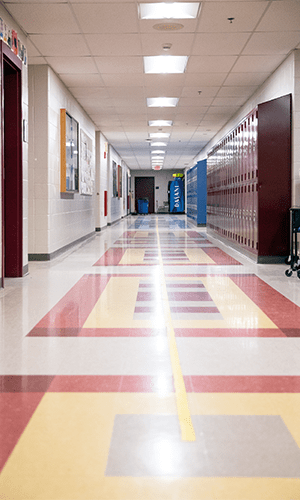
Like his colleagues, Camenker saw an increase in students’ stress levels. “You get into the profession to support kids,” he says. “That means supporting their social and emotional needs as they are on this roller coaster. For kids who worry to begin with, there’s more to worry about.”
As a language arts teacher, he finds reflective writing and creative journaling are not only great learning opportunities, but ways for students to express their feelings about what the pandemic has been like.
“The nature of sharing is paramount to the subject area. We read a dystopian short story and discuss how a character’s experience relates to theirs. Reading a Ray Bradbury story, we talk about censorship: What would it be like if information about the Coronavirus is censored years from now? It’s impressive how they can express their thoughts about these issues and find relevance to their lives.”
Ed Joyce ’94 supervises Camenker and around 100 other staff members as principal of Ross A. Lurgio Middle School. Due to social distancing guidelines from DHHS, only half the students attended school each day until mid-February, resulting in smaller classes. Although students disliked many parts of the pandemic, Joyce says they enjoyed increased teacher attention and camaraderie: “The kids loved it, and it allowed us to really connect with them. Instead of getting off the bus and socializing in the hallway, students went directly to a homeroom with kind of a mini-family.”
He calls it their “Bob” year: the best of a bad situation. “So many parts of middle school are important to social development. When I talked to parents, it wasn’t the academic level they were concerned about so much; they were worried about their kids feeling isolated. Our guidance department works extra hard, doing a lot of checking in with students. We’ve made great progress, but the pandemic has taken a toll on students’ socialization.”
Teachers worked harder than ever under extreme stress, Joyce says. “We redesigned our educational model three or four times. That’s a herculean task. I’ve been as candid and honest as possible with my dedicated staff, and empathize as much as possible. I try to keep them well informed regarding potential changes to guidelines or practices.”
Ross A. Lurgio Middle School is near Saint Anselm College, and Joyce has had many Anselmians on his staff or completing field experience in his 14 years as principal. “A sense of higher purpose abounds at the college,” he says. “You learn to think about who you are, what you value, and what your contribution to the world will be. The teachers who come out of there see it as a vocation, a calling. You’re lucky to have educators like that on your team.”
Abigail Dickey ’21 could be speaking for any of the 30 student interns completing their full-time teaching placement in the spring of 2021. Dickey, a double major in history and secondary education, spent part of her senior year at Ross A. Lurgio Middle School, often working alongside Camenker.
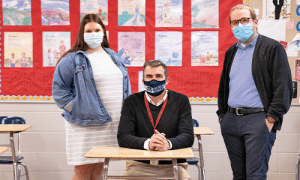
“This has been one of the hardest yet most rewarding academic experiences I’ve had at Saint Anselm,” she says. “This is not the experience I’d been anticipating. Balancing student teaching, my classes, the pandemic, and trying to enjoy my final semester on the Hilltop has definitely been a big challenge. I’m learning from my clinical educator every day, but I’m also taking two classes and completing my Teacher Candidate Assessment Performance. In a way, I can relate to my students as being a student during a pandemic and struggling with remote learning.”
Despite the unusual situation, Dickey says it has made her even more excited to become a teacher: “Everyone tells you you’ll experience exponential growth during your student teaching. Despite Covid-19, this growth is happening.”
The way students have handled the situation inspires her. “They show up to school ready to work and learn. In fact, they were eager about coming back to school 100 percent of the time,” she says.
The rewards of being a teacher are even greater in this time, Dickey believes. “I think, more than ever, people realize how important education and access to education are.”
Masters of Modality
Sue Downer ’83 sits at a shiny lab bench, her back to a 15-foot-long whiteboard. The image projected onto the board describes how to calculate acidity in the different regions of a titration curve—one of the skills her AP chemistry students must master, especially if they are going on to college and science careers. Souhegan High School Classroom 223 looks as it usually does, with a periodic table of the elements front and center… except that Ms. Downer’s friendly smile is hidden by a blue mask and some of her students are—literally—miles away.
In 25 years as a science educator, Downing says teaching during the pandemic is “by far the weirdest and most challenging” situation she has encountered. She taught in three modalities: fully remote with students on Zoom, teaching from home with some students on Zoom and some in the classroom, and in person with some students remote. It required flexibility, creativity, and many 12- to 13-hour workdays.
“I’m very committed to having students do science, not just absorb information. I use hands-on activities to allow them to discover and apply concepts,” the veteran teacher says. “Without these activities, I’ve had to find other engaging ways to explore a concept. I’ve rewritten my entire curriculum to match the modality we’re in.”
Downer’s AP chemistry students met remotely on four days and came to the lab in person once a week. They could not all be in the room at once, so she ran the lab three times on each of those days. She also ran at-home labs, with students organized into virtual breakout rooms. “I’d go from room to room watching them do the experiments, using household items, sometimes with a brother or sister doing the mixing,” she says. “They don’t have beakers in their kitchens, so I’d convert grams into tablespoons.”
Assessing students’ work was one of many challenges. “You can’t give a test when half the students are at home and have access to the internet, cell phones, and siblings,” she says. “We’ve had to look at formative assessment in a different way.”
Joseph Parodi-Brown ’06, a Spanish teacher at Marianapolis Preparatory School in Thompson, Conn., faced similar challenges. “Forty percent of our students went home to other countries and couldn’t return to school physically when we came back at the start of the school year. Synchronous classes are really important to us. It was a challenge to schedule classes for a time that wouldn’t be the middle of the night for those students,” he says. Yet, like Downer, he chooses to look for the good. “The silver lining is that we took the opportunity to see what really matters and reassess what we’re doing. How will we move forward with what we now know?”
You learn to think about who you are, what you value, and what your contribution to the world will be.
- Ed Joyce '94
As always, Downer strives to be attuned to her students’ emotional well-being. “Zoom exhausts kid,” she says. “It’s more stressful when they aren’t able to do the work with their peers. And when they’re home working remotely, their day never changes. I cut my 100-minute periods to 80 minutes because of Zoom fatigue.”
Downer worries school might be a scary place to kids who haven’t been there physically for a year and a half. She prefers to focus on the positive aspects of gaining new technology and finding new ways to assess students’ learning: “I hope we’ll ride that train and change education for the better.”
Creativity Is the Key
Colleen Reilly ’20 feels at home in a class full of kids. Her mom teaches kindergarten, and Reilly grew up volunteering in classrooms. At Saint Anselm, she had classroom experience starting in sophomore year.
“I never expected that, when I got my first real teaching job, it would all be on the computer,” she says.
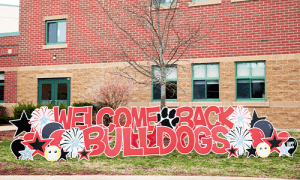
Reilly teaches second grade in Worcester, Mass., where she grew up. Teaching in an inner city school was exactly what she wanted, despite the challenges of a high proportion of economically disadvantaged families. Her students come to her below grade level.
School started fully remote in September and moved to a hybrid format at the end of March. Initially, low access to technology was a barrier. Many children lack support at home, or are in charge of siblings. “Sometimes I hear things I don’t want to hear,” Reilly says. “Or a kid shuts off the computer because he doesn’t want me to know what’s going on in his house.”
Being innovative is crucial. “At Saint Anselm, you learn to be a problem solver. I have to find ways to make my students look forward to being on a computer for six hours.” She cites a phonics lesson that just wasn’t going anywhere until she had the students make the shapes of the letters with their bodies—and joined them, on Zoom.
Reilly believes the culture of Saint Anselm College prepared her for this responsibility. “Saint Anselm is such a place of belongingness. I need to provide these kids not just with academics but with community. I want them to know we’re a classroom and they belong here, even if they’re on a computer. At the end of the day, at least I know that I cared for them and gave them a place to belong.”
Supporting Students and Parents
For Elizabeth Parent ’11, the pandemic had an unexpected upside. When she was laid off by a public school early in the pandemic, she needed another job. She found one she liked even better. “Starting a new job in a pandemic is hard, but I love it. I feel like I’m supposed to be here,” she says.
“Here” is New England Pediatric Day School, in Billerica, Mass., where her students, aged 3-14, are nonverbal and have severe disabilities. The special education teacher meets with them in their rooms, where she focuses on keeping their senses engaged and giving them access to communication through technology. She wears a surgical gown over her street clothes as well as an N95 mask, goggles, and gloves—all of which are changed several times in a day.
“The kids’ health is fragile, but being six feet apart simply is not possible,” Parent explains. Hearing and vision difficulties make remote learning impractical, but group sessions are out.
At first, she felt nervous about being in close contact. Now, precautions are second nature. “We’ve had positive cases at the school, but, thankfully, not extremely severe,” she says, adding that she has been exposed and quarantined many times. “The holiday surge in cases was especially stressful; by December, a lot of us had hit a pandemic wall.”
As usual, Parent finds the upside: Teaching one-on-one for safety reasons allowed her to have relationships with them that she wouldn’t have had in a group setting.
If her students’ needs are complex, so are the needs of their families. Due to the pandemic, family visits to the facility are limited. Parent recalls a mother feeling guilty when she missed a scheduled FaceTime call because she was overwhelmed by pandemic-related issues: “I told her I understood. Parents are doing the best they can, but their lives have been turned upside down.” Nikki Amara Myers ’93 is in her fifth year as a school counselor at Fontbonne: The Early College of Boston, a Catholic all-girls college preparatory high school with a student body of about 230 students from 35 communities surrounding Milton, Mass.
I have to find ways to make my students look forward to being on a computer for six hours.
- Colleen Reilly '20
“Being a school counselor in a school this diverse is exhausting work but wonderful,” she says. “Worries about work are always there, but now it’s much harder. Polarization became obvious regarding remote versus in-person learning; I worry constantly about students, faculty, staff, and myself. I get up in the middle of the night and make notes about students, issues that need my immediate attention, and how I’m going to do it all, and do it well.” She had to quarantine three times, and once from her own family.
Myers saw an increase in mental health issues and emotional dysregulation, affecting motivation, academic performance, and self-care. Students sometimes acted out, opting for behaviors unlike them as a result of feeling anxious, bored, overwhelmed, and isolated. Unfortunately, in virtual meetings, she says, some students don’t put the camera on because they don’t want to show their home or life outside school. It can feel like a violation of privacy.
The six-foot rule can be tough for a school counselor. Myers meets with students wearing a mask, and sitting behind a sneeze guard. “My office is small, so, at all times, the student might be sitting in the doorway. Not ideal when your conversation is confidential,” she says.
She meets with students in person and virtually, before school, during lunch, and as needed after school, evenings, and weekends. “I’m always checking on my students to make sure they’re OK. I spent hours last spring talking remotely with a student who tested positive along with her whole family. She was sick, sad, and scared. Fontbonne rallied around the family, and we did everything possible for the student to graduate on time.”
I'm always checking in on my students to make sure they're O.K.
- Nikki Amara Myers '93
More Than a Teacher
For student teachers, who will soon be entering the real world, Dianna Gahlsdorf Terrell, Ph.D., associate professor and education department chair at Saint Anselm, feels this past year has enhanced students’ capacity to be empathetic teachers.
“They may not agree, but I think this challenge has brought out the best in them,” she says. “The pandemic has laid bare the reality that schools and teachers fill many roles for children, adolescents, and young adults that go far beyond academic instruction,” Terrell says. “Teachers are getting to know the realities of their students’ lived experiences and are feeling acutely by proxy the traumas school-aged children are enduring due to the pandemic.”
Terrell regularly talks with seniors in her capstone class about how the pandemic will continue to fundamentally reshape the profession. “I am truly impressed by the ways the Saint Anselm teaching interns have stepped up to this challenge. They have always exhibited a mature, reflective, and professional presence in the K-12 classroom. They’re focused on the most important goals and they’re committed to their colleagues, their own students.”
Finding a New Beat
Music and art educators have had their work cut out for them this past year, and no one knows this more than Ryan Burns, D.M.A. ’07, director of music for the Pomfret School in Pomfret, Conn., and Michael Akinlosotu ’18, a music production instructor with the Indivisible Art Collective in Washington, D.C.
For Akinlosotu, who teaches marginalized youth, the inability to be in the presence of students, combined with technological issues, have made teaching difficult. Akinlosotu helps students create their own original music, including everything from teaching them how to prerecord sounds to editing audio to meet radio volume standards. He sees firsthand the power music has on students. “[It] gives kids a fun, creative outlet … to express themselves in ways they can’t through natural language,” he says.
As a student, Akinlosotu worked in the Meelia Center for Community Engagement, where he discussed music and life solutions with youth in detention centers, and taught basic coding in python, a primary coding language, to underrepresented high school youth. This experience helped him navigate the challenges of teaching during the pandemic. “Teaching music production allowed me to get better as a musician, it helped me get better at adapting to different learning styles and speeds, and to be more aware of people’s feelings and situations to meet them where they are.”
In addition to being director of music at the Pomfret School, Burns is program coordinator for the JOY! Conservatory Program through the University of Connecticut. The program allows area middle and high school students to pursue private music lessons, and oversees all musical activity at the Pomfret School. He also directs its honors vocal chamber ensemble and teaches private voice lessons among other electives.
The Pomfret School has been following a hybrid learning model, with Burns’ duties being split between in-person and remote. “Technology cannot replace the human connection of being in the same space with another person,” he says. Still, with the alternative being no music at all, this is the preferable option. “All of us, young and old, students and teachers, need ways to express ourselves now more than ever—the arts provide such an essential medium to do that.”
Burns attributes his time at Saint Anselm to his career in the arts: “If it were not for the Creativity course I took … I am not sure I would have ever made the decision to change paths and pursue the arts full time.
—Alex Fischer ’21
Keeping Kids Fed
When schools shut down in March 2020, the first thing that went through the mind of Cheri White ’83, M.S., S.N.S., was “we still need to feed kids.” The administrator of the office of nutrition programs and services at the New Hampshire Department of Education in Concord, N.H., knew she and her team had their work cut out for them as the state, and the world, struggled to make sense of what was happening with Covid-19. Yet the motivation was strong: making sure kids didn’t go hungry. “This was important now more than ever when everything was shutting down, parents were out of work, and everyone was home,” she says. “Our biggest concern was how we were going to get food to those kids.”
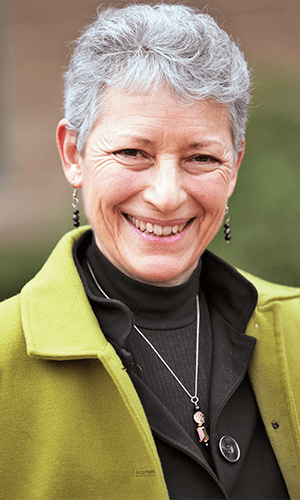
The answers came with lots of long hours, numerous conversations, and sheer grit. “Schools are used to thinking creatively, and educators are a very collaborative group, and we were on the phone day and night with administrators, guidance counselors, teachers, listening to problems, hearing about creative solutions, and then getting to work to support everyone in any way possible,” she says.
For White and her team, this involved countless hours coordinating with the USDA to temporarily amend rules and regulations concerning food delivery and food consumption within the public schools. “There are very strict guidelines on when and where children can eat within schools, and rightly so” she says. “We worked diligently with the USDA—whose main concern also was to keep children fed—on how to make that happen.”
In many situations, this resulted in setting up lunch pickup locations for parents, as well as utilizing bus drivers to deliver food to families on what was formerly their regular bus routes. It also included expanding meals from just lunch to include breakfast, and partnering with other agencies and community organizations to offer snacks and dinner as well.
While White can’t compare how many more meals were served this year to last year, she can say that 13.5 million meals were provided to kids in New Hampshire this past year. But White is quick to shift any praise for this success to the local schools. “We are the guidance people,” she says. “The real heavy lifting was done by the food service staff at every school.”
White, who can’t remember having a job that didn’t involve food (her first paid job was picking raspberries at age 12), credits her ability to navigate difficult situations, namely the one she’s been handling for the past year, to her liberal arts education on the Hilltop. The biology major who earned her master’s degree in nutrition at Case Western Reserve University in Cleveland, Ohio, is not shy about admitting college was hard work. “I never was the best student, but I was one of the hardest workers, and I think Saint Anselm really shaped who I am.”
She credits the faculty for this, particularly Professor Emeritus Robert Normandin ’50 of the biology department. “I worked for Professor Normandin inputting test scores into the computer—it was my first experience with a computer,” she says. “My senior year, he asked what I was planning on doing after graduation and I told him I was going to be a chef—but I admitted this career path probably made my biology degree a waste.” His answer surprised her, and sticks with her today. “He just looked at me and said, ‘Cheri, what do you think we’ve been teaching you for four years? All we’re trying to do is teach you how to think—what you do with that is completely up to you.’”
—Kate Grip Denon
